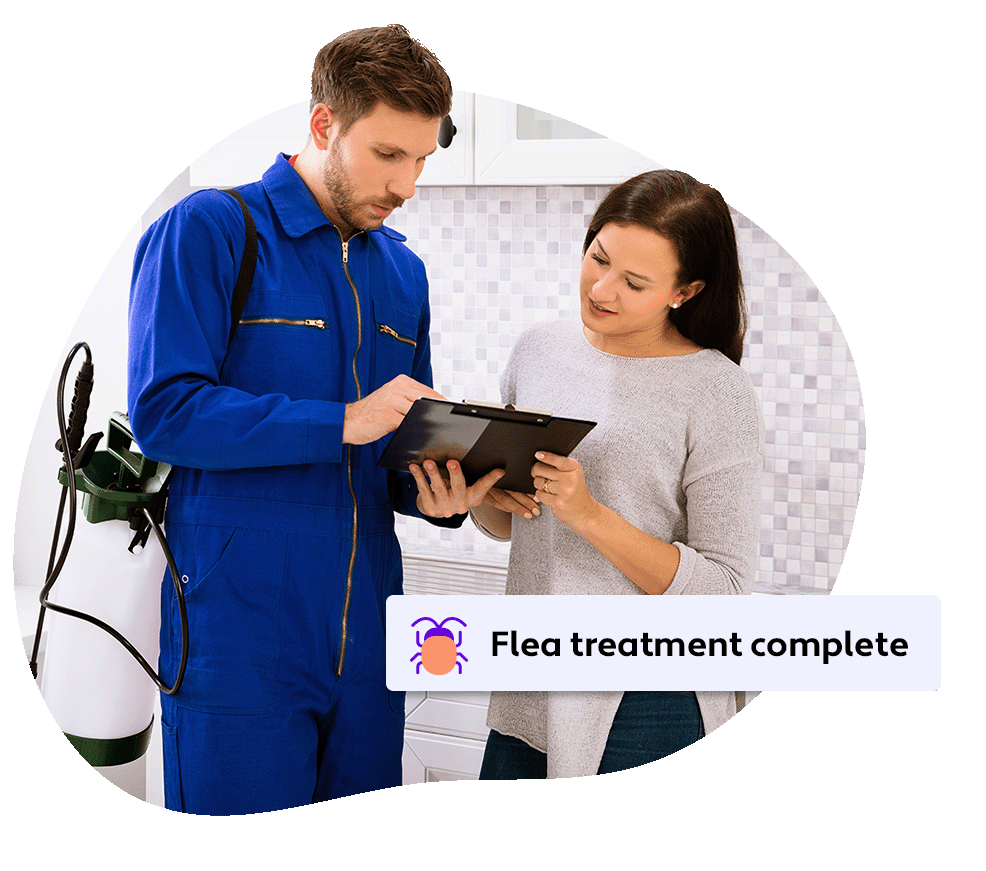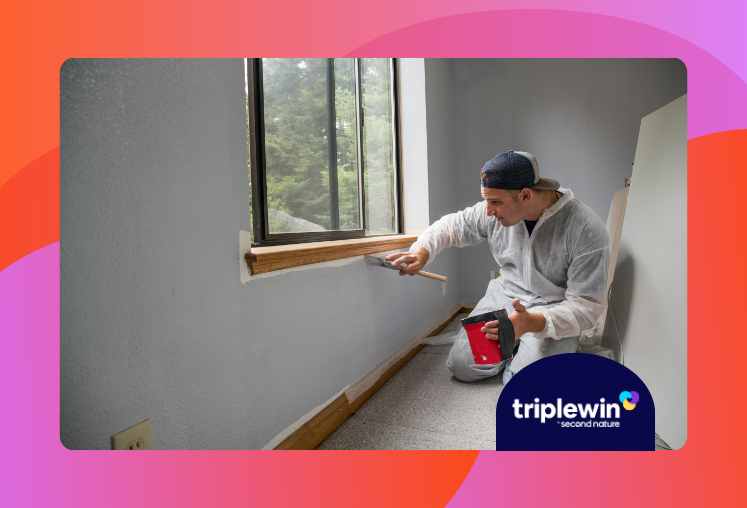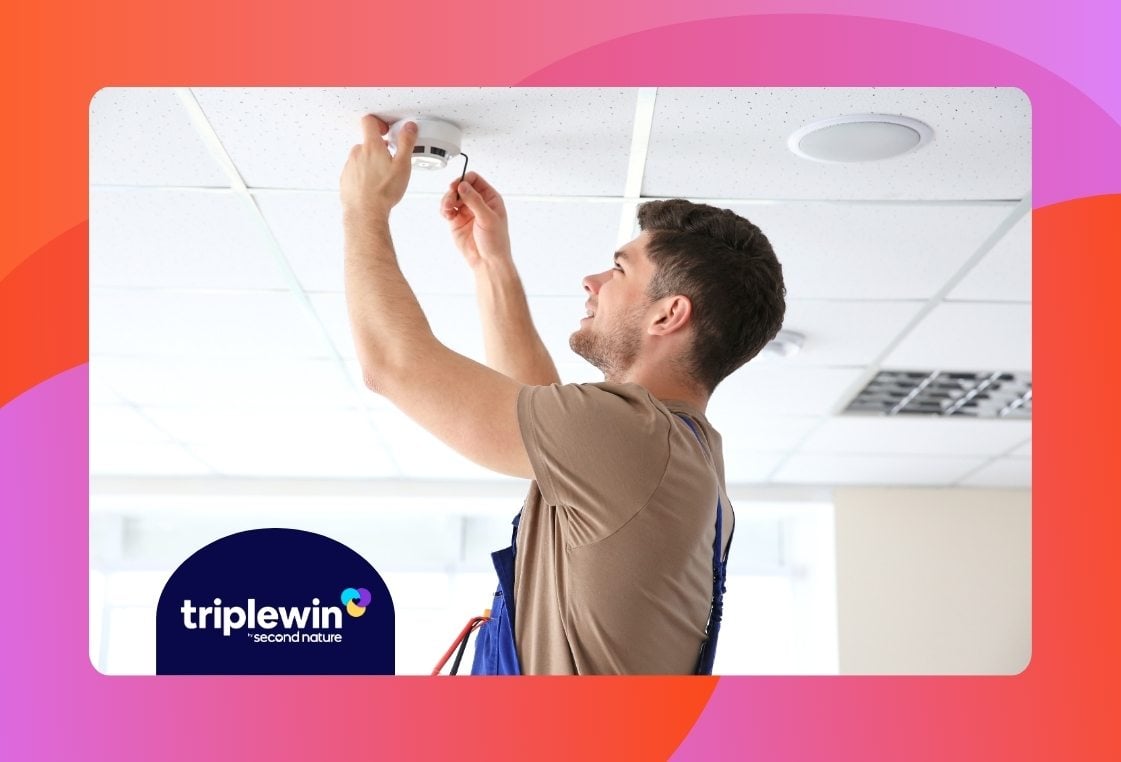What we'll cover
What is property maintenance?
Benefits and challenges of property management maintenance
Examples of maintenance in property management
What to look for in property maintenance workers?
What should an ideal property management maintenance solution have?
How to effectively manage a property maintenance team
How does a Resident Benefits Package help reduce maintenance needs and costs?
Why property maintenance can make or break your success as a PMC
How to reduce property maintenance costs
Property management maintenance is one of the most important parts of the resident experience. But property management maintenance software can help control costs and challenges. We've heard from hundreds of property managers that maintenance can be one of the most unpredictable parts of their job – and one of the biggest headaches for residents, property managers, and real estate investors.
Triple headache!
Of course, the unique frustrations and challenges of rental property maintenance also mean that an effective strategy can become one of the most outstanding differentiators for a property management company.
So, how do leading PMCs take their routine maintenance practices to the next level? How can PMCs turn that triple headache into a triple win?

Here's what we've learned from years of working with PMCs and delivering property maintenance services that support both the resident and the property owner.
What is property maintenance?
Property maintenance is everything involved in ensuring your properties are in excellent shape and any issues are repaired in a timely manner. Property managers take responsibility for maintenance in most cases, and their tasks include both preventive and preventive maintenance.
Property maintenance may include:
- Resident maintenance requests
- Servicing and repairing HVAC systems
- Pest control
- Landscaping
- Painting and repairs
Maintenance is critical to the resident experience, to keeping a property fully functional, and to ensuring safety and quality of life. Failure to follow through on regular inspections and maintenance can result in serious consequences.
Property managers must balance their residents' needs and their investors' goals. For example, what if an investor isn't interested in putting a whole lot of maintenance or repairs into a specific property – but the resident wants a higher level of service?
Another layer of complexity is the round-the-clock nature of maintenance tasks. You don't know when a roof will spring a leak, an HVAC system will go haywire, or a dishwasher will give up the ghost. Property managers have to juggle on-call hours, after-hours, increasing work orders, and emergencies all the time.
Benefits and challenges of property management maintenance
That's all easier said than done! Property management maintenance is uniquely challenging. It's unpredictable, almost always urgent, and involves several stakeholders and fluctuating pricing.
Related: Best Property Management Maintenance Software
Bottom line: How do you build solutions that support your team, the resident, and your investor? Let's look at both the benefits and challenges of property management maintenance.
Benefits of property management maintenance:
- Extending the life of properties and equipment
- Reduced costs
- Ensuring resident health and safety
- Boosting the resident experience with high-quality homes
- Avoiding liabilities and accidents
- Increasing property value
- Happier tenants!
Challenges of property management maintenance:
- Prioritizing reactive and preventive maintenance
- Increased expenses and maintenance costs
- Delegating tasks to your team
- Managing resident expectations
- After-hours and emergency work is 24/7
- Balancing investor's goals and resident's needs
Examples of maintenance in property management
Here are some top examples of property management maintenance company services for single-family homes.
Spring property maintenance checklist:
- Check gutters and downspouts for blockages left over from the winter
- Check interior for any mold or mildew growth
- Start prepping landscaping for summer with new flowers or shrubs
Summer property maintenance checklist:
- Clean window wells, gutters, and downspouts
- Find and fix any gaps in windows, doors, and walls (to keep out pests and ensure HVAC efficiency)
- Maintain yard and landscaping if that's within your responsibility
- Increase watering frequency
- Prune trees and any hazardous limbs
- Lawn care
- Check outdoor lighting
- Pressure wash and repair outdoor areas/decks
Fall property maintenance checklist:
- Check the roof and exterior for leaks or repair needs
- Clean chimney for cold weather
- Clean gutters and downspouts again
- Prep landscaping for winter
- Remove dead leaves, branches, etc.
- Prep sprinkler system for winter
Winter property maintenance checklist:
- Ensure roof is in good state for winter
- Check batteries in smoke and carbon monoxide detectors
- Ensure pipes, windows, and doors are insulated
- Cover and winterize outdoor areas, including pools and pipes
What to look for in property maintenance workers?
When property management companies consider hiring in-house maintenance workers or contracting with property maintenance services and technicians, there are several key qualifications and skills to look for. These not only ensure efficiency and quality in maintenance tasks but also contribute to the overall safety and longevity of the property.
Here's a checklist of what to look for:
- Experience in managing repairs: Look for a proven track record in handling a variety of repair tasks. This includes the ability to diagnose issues quickly and provide effective, long-lasting solutions.
- HVAC systems expertise: Essential knowledge in maintaining and repairing HVAC systems is crucial, given their complexity and how important they are to resident comfort.
- Boiler maintenance skills: Expertise in maintaining and repairing boilers, especially in regions with colder climates where heating systems are in constant use.
- Installation abilities: Proficiency in installing various types of equipment—ranging from basic fixtures to complex machinery.
- Electrical and plumbing knowledge: A solid understanding of basic electrical and plumbing systems ensures that routine issues can be addressed promptly and safely.
- Certifications and training: Relevant certifications or completed training courses in property maintenance or specific systems (like HVAC or electrical work) add credibility and assure competence.
- Problem-solving skills: The ability to think on their feet and creatively solve unexpected problems that arise during maintenance work is key.
- Communication skills: Clear communication with property management team and tenants is essential, especially when coordinating repairs and addressing tenant concerns.
- Attention to safety: A strong focus on safety protocols to prevent accidents or property damage, including adherence to all relevant regulations and guidelines.
- Customer service orientation: Since maintenance technicians often interact directly with residents, a friendly demeanor and strong customer service skills are important for maintaining tenant satisfaction.
By ensuring that your maintenance staff or contracted technicians meet these criteria, property management companies can maintain high standards in property upkeep, leading to satisfied tenants and well-maintained properties through the support of a qualified maintenance technician.

What should an ideal property management maintenance solution have?
We've spoken with leading property managers across the industry and collected some of their best tips for taking the puzzle of property maintenance and delivering next-level service and experiences.
Here are three key steps they've shared for leveling up when it comes to property maintenance services.
1. The right team
Getting the right “who” is critical before addressing the “how” in your day to day operations.
We spoke to leading property management consultant Kevin Hommel about what he looks for in his property management team. He looks for people who are proactive, self-driven, and resilient in the face of complex problems. Maintenance is no exception. A self-driven team will always aim to be proactive rather than reactive.
Hommel says:
“I would rather find somebody who is going to come in and hustle – even if I have to teach them everything about property management – than find somebody who's a property management expert but has the wrong attitude. It's going to be a completely different experience.”
The benefits of finding the right full-time or part-time team are twofold: First, you'll produce better work and better service. Second, a trustworthy team helps you focus on bigger strategic opportunities. As a property management business owner, you should be free to focus on 10X opportunities rather than get bogged down in day-to-day tasks.
Peter Lohmann, Co-founder & CEO of RL Property Management, says it this way:
“In property management, a lot of us are in the habit of wanting to know what's going on at all times – every rental application, every maintenance request, works orders, every disbursement amount. But I would challenge everyone to step back from that and ask yourself, ‘Why?' The need to ‘stay plugged in' is not going to help you unlock growth for your company. Time to work on 10x opportunities instead.”
By hiring a team you can trust, you're setting your residents up for success. You know they'll be taken care of, and you can focus on higher goals to improve your resident experience overall.
2. A clear process for managing requests
After setting up your team – and before we get to the tools you can use to support them – we need to talk about the process. Every property manager we've spoken to is bullish when it comes to getting your processes right.
“(It's important to) do things in a standard way throughout your business. The more exceptions and one-off arrangements you make with the property owner and tenants, the harder this becomes. Your priority should be to standardize all your contracts and operating procedures so you can innovate around a small number of core processes that apply to every unit you manage.”
This is more than just having a maintenance checklist. The best way to build a process with preventive measures is to approach it from the lens of the resident experience. The most successful property managers set up maintenance processes by asking themselves what the resident wants and needs:
- What's the easiest way for a resident to report an issue?
- In what way do residents like to communicate with me or hear from me?
- How can I best keep residents informed?
- How can I bring speed and convenience to residents?
Using an experience lens to build or update property maintenance processes can help you see new opportunities.

3. The right tools and technology
Automation and AI are some of the newest ways to support your team and improve functionality. No-code tools and app integrations help connect workflow, client management, communication, and task tracking. No-code tools are products that enable those of us with no coding experience to build digital solutions for every part of our workflow. Property managers can use no-code tools to design their websites, build online content, create email campaigns, or set up automated task tracking, communication, and more.
In terms of property maintenance, PMCs can now use accounting platforms with native portals for maintenance requests or adopt maintenance solutions platforms like Meld. These solutions offer customizable automation where you can track tasks, deadlines, time, vendors, costs, and employee responsibilities. With just a few clicks, automation helps cut out manual work like:
- Creating a New Property Checklist every time you add a new door
- Populating data fields in your CRM
- Assigning the correct tasks to the correct people
- Sending an email to a property investor with updated information
- Sending maintenance reminders
- Tracking safety checks and code enforcement
- Etc.
Property management software and partner maintenance services can include features like:
- Tenant portals for maintenance requests and more
- 24/7 and after-hours call center services
- Accounting platforms
- Self-help video libraries and knowledge base platforms
Technology ultimately brings greater speed, convenience, and ease to you and your residents.
These features help streamline maintenance management for property managers and technicians.
4. A resident benefits package
Whether you're already implementing automation or if that feels a long way off, we still haven't addressed one of the best tools for boosting resident experience: the Resident Benefits Package, or RBP.
An RBP is considered by many property managers as the most powerful, profitable step to impact the resident experience. And it is the only one that generates revenue while also creating operational efficiency.
RBPs provide tools like filter delivery service, identity protection, rewards programs, on-time rent incentives, credit building, move-in concierges, insurance, and more.
Here's just one example: The National Rental Home Council (NRHC) surveyed 7,772 single-family residences over 18 months to analyze the frequency of resident HVAC service requests with and without HVAC filter delivery service.
Second Nature delivered HVAC filters every 60 to 90 days in a date-stamped box with illustrated instructions and sent emails with tracking information and educational content before each delivery. Overall, there was a 38% reduction in HVAC-related ticket requests among the group that received filter delivery—a result achieved without creating any additional work for the property management company.
Resident benefits packages help standardize benefits in a cost-effective way across all your properties. With an RBP, you know every resident is getting a level of service that feels high-touch but doesn't create any extra work for your team. RBPs strengthen communication, transparency, self-service, and speed – in other words, the resident experience and relationship.
How to effectively manage a property maintenance team
Managing a property maintenance team efficiently is key to ensuring your properties are well-cared for, and your residents remain satisfied. From scheduling tasks to fostering teamwork, every aspect plays a crucial role. In this section, we'll break down essential tips into actionable strategies to help you lead your maintenance team effectively.
Establish clear communication channels
Effective communication is the backbone of successful team management. Establishing clear channels for reporting issues, discussing solutions, and sharing feedback ensures everyone is on the same page. Use digital tools like email, messaging apps, or property management software to streamline communication.
Implement a scheduling system
A well-structured scheduling system is crucial for organizing maintenance tasks. Make sure your maintenance team uses digital calendars or maintenance management software to allocate tasks, set deadlines, and track progress. Ensure their schedules are flexible enough to accommodate emergency repairs while maintaining routine maintenance work.
Prioritize tasks based on urgency and importance
Not all maintenance tasks carry the same weight. Prioritize issues that directly impact resident safety and comfort, such as HVAC problems or plumbing leaks. Regular maintenance can be scheduled around these more urgent tasks to ensure efficiency without compromising on critical repairs.
Use technology for efficiency
Leverage technology to automate reminders, maintain records, and manage work orders. Property maintenance software can significantly reduce manual administrative work.
Regularly evaluate performance
Conduct regular assessments of your maintenance vendors. Use these evaluations to identify areas for improvement, acknowledge accomplishments, and set goals for future growth.
Encourage feedback from residents
Residents are often the first to notice maintenance issues. Encourage and facilitate easy ways for them to report problems. This feedback can be invaluable in identifying areas that need attention and enhancing resident satisfaction.
Plan for preventive maintenance
Instead of always being reactive, schedule regular preventive maintenance checks. This proactive approach can significantly reduce the frequency of emergency repairs and extend the life of property assets. Building in solutions like a Resident Benefits Package can bring residents on board with prevention strategies, too.
Balance workload fairly
Ensure that the workload is evenly distributed among team members if your team does the maintenance work. Overburdening certain individuals can lead to burnout and reduce the overall efficiency of the team.
How does a Resident Benefits Package help reduce maintenance needs and costs?
Managing single-family properties presents unique challenges, particularly due to the fact they're generally scattered-site management. This setup can make regular maintenance a logistical and financial burden for SFR property managers. But a well-structured, fully managed Resident Benefits Package (RBP) can make a huge difference in alleviating those challenges.
At Second Nature, we built an RBP with integrated solutions that support and empower residents to take better care of the properties themselves. This helps reduce maintenance needs over time.
Take air filter delivery: Simply subscribing to HVAC filter delivery can reduce HVAC ticket requests by 38% and save hundreds in energy bills.
Another example is pest control. On-demand pest control can ensure residents deal with pest issues immediately. Instead of paying for expensive prevention, you can be sure actual issues are dealt with before they escalate.
Or, consider resident rewards. With a built-in rewards program, property managers can customize the behaviors they want to encourage. Small preventive tasks or maintenance checks can be included in those incentives.
Maintenance, tracking down vendors, invoicing work orders, etc., will always be a part of the property manager's life. But with an RBP, you can significantly cut down on the time and money you spend on a maintenance team.
Why property maintenance can make or break your success as a PMC
You've heard this from us before, and you're going to hear it again – it's all about the resident experience. Retention depends on it.
Consumers today are looking for products that can offer them:
- Ease and convenience: Thanks to companies like Uber and Amazon, consumers are now used to having solutions at their fingertips – or the click of a button.
- Personalization: With our data everywhere, we've all become accustomed to brands that know us more intimately than ever before.
- Automation or speed to answer: Smart homes and connected devices can solve problems remotely and quickly. Even though PMs aren't robots, we see more PMs solving with digital solutions and proactive services like resident benefits packages that anticipate and deliver on residents' needs before they become problems.
The modern resident has different expectations than the generation before. The “convenience economy” has come for us all. Residents don't just expect to have maintenance issues resolved. They expect management services to provide a certain level of ease, comfort, familiarity, and convenience.
Of course, maintenance work has obvious urgency: Nobody wants to live with a clogged toilet, a leaky faucet, no hot water, backed-up gutters, etc. But emergency repairs are now the minimum that property managers provide.
Property management maintenance is integral to the resident experience – and one of the primary ways to set your business apart. We're not just looking for “good enough” – we're looking to answer the question: “How do we create experiences so good that residents never want to leave?”
Regarding rental property upkeep, delivering on that question will involve many factors:
- Safety first: Safety is the baseline for all properties. If residents don't feel safe, they are not likely to stay. Staying on top of carbon monoxide detectors, leaks, etc., is paramount.
- Timeliness: According to Ray Hespen, “the biggest leading indicator for resident satisfaction is speed.”
- Transparency: Whether through an online dashboard, text communication, or other tools, residents expect to know what's going on with their homes.
- Preventive maintenance: We have to go beyond reactive maintenance. Processes that prevent issues from occurring can save time and money and boost the resident experience. We'll talk about how resident benefits packages can deliver this for PMCs.
- First-time fixes: Nothing is more frustrating than getting something fixed only to realize the maintenance team didn't actually resolve the issue.
- Communication: Residents don't want to explain themselves or the problem several times to different parties like the property manager, the vendor, etc.
- Self-service: Many residents like the control and convenience of self-service options like air filter delivery or online payment portals.
These are the characteristics we're seeing across some of the most successful property management companies – the PMCs standing out from the crowd.
How to reduce property maintenance costs
Maintenance costs can quickly spiral if not carefully managed, but with strategic planning and smart practices, you can significantly reduce these expenses without compromising on quality or resident satisfaction. Let's dig into a few practical tips that will guide you on how to efficiently lower your property maintenance costs, ensuring your operations remain both cost-effective and top-notch.
Implement preventive maintenance
Proactive maintenance can significantly reduce long-term costs. By implementing services that protect key elements like HVAC systems, plumbing, and electrical circuits, you can prevent minor issues from becoming major expenditures. Services like air filter delivery create excellent return on investment when it comes to prevention like this.
Use energy-efficient solutions
Invest in energy-efficient appliances, lighting, and HVAC systems. These not only reduce energy costs but also tend to have a longer lifespan and lower maintenance requirements. Consider LED lighting, energy star-rated appliances, and smart thermostats to boost efficiency and cut costs.
Train staff on basic repairs
Equip your team to handle basic repairs for commercial properties in-house if it makes sense for you in terms of time and cost. Training staff to fix common issues like minor leaks, electrical faults, or appliance glitches can save on expensive contractor fees. However, ensure more complex tasks are left to professionals.
Negotiate contracts with vendors
Establish long-term relationships with trusted vendors and negotiate contracts for regular maintenance services. Buying services in bulk or agreeing to long-term contracts can often result in significant discounts. Ensure these vendors are reliable and offer competitive rates for their services.
Monitor and manage inventory efficiently
Keep a close eye on your inventory of maintenance supplies if that's something your team manages. Bulk purchasing of frequently used items can save money, but be wary of overstocking, which can lead to waste. Use inventory management software to track usage and avoid unnecessary purchases.
Optimize use of technology
Leverage technology for maintenance management. Use property management software to track maintenance requests, schedule work orders, and monitor expenses. This can help in identifying patterns or areas where costs can be trimmed without compromising on service quality.
Conduct regular financial audits
Regularly review and audit your maintenance expenses. This practice can help you identify areas where you may be overspending, spot inefficiencies, and adjust your maintenance strategies accordingly to ensure cost-effectiveness.
If you want to build a differentiated resident experience people pay for and stay for, learn more about our or subscribe to our podcast for regular insights from the PMC world.
Topics:




